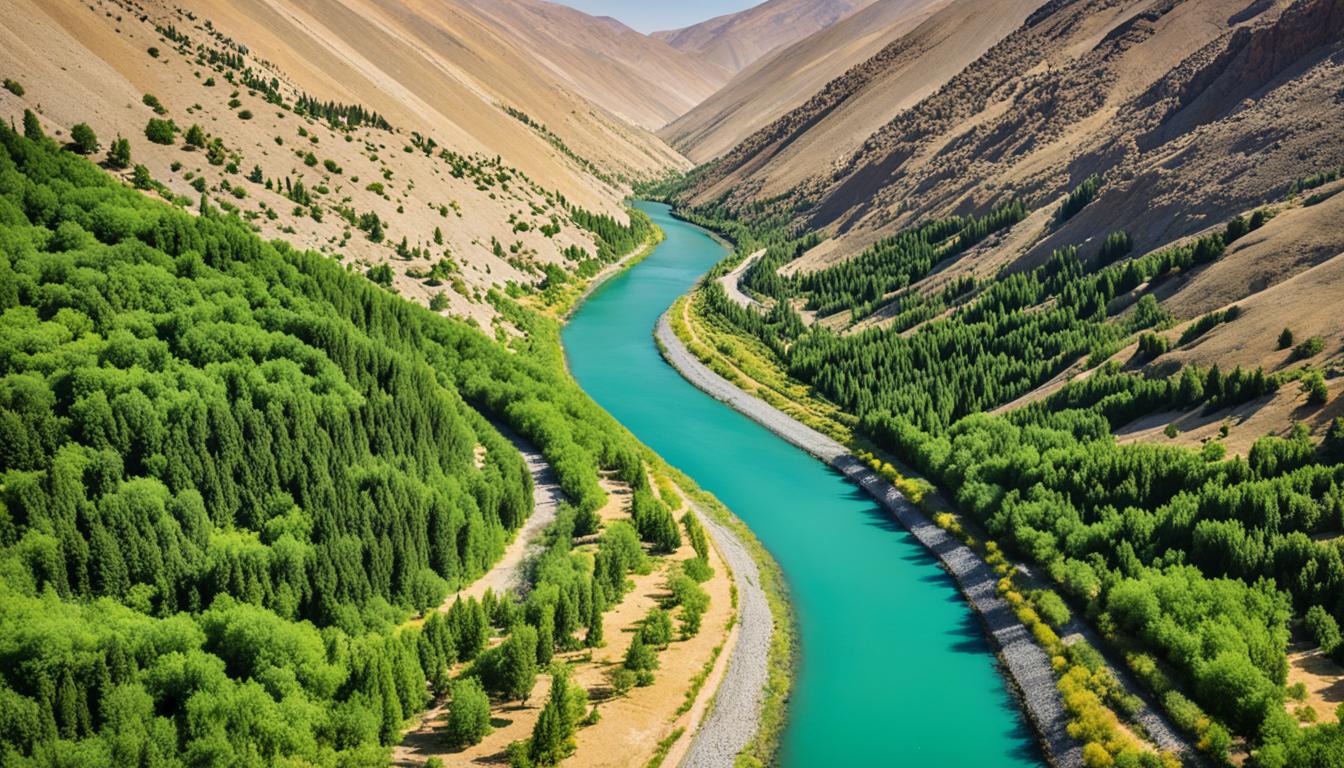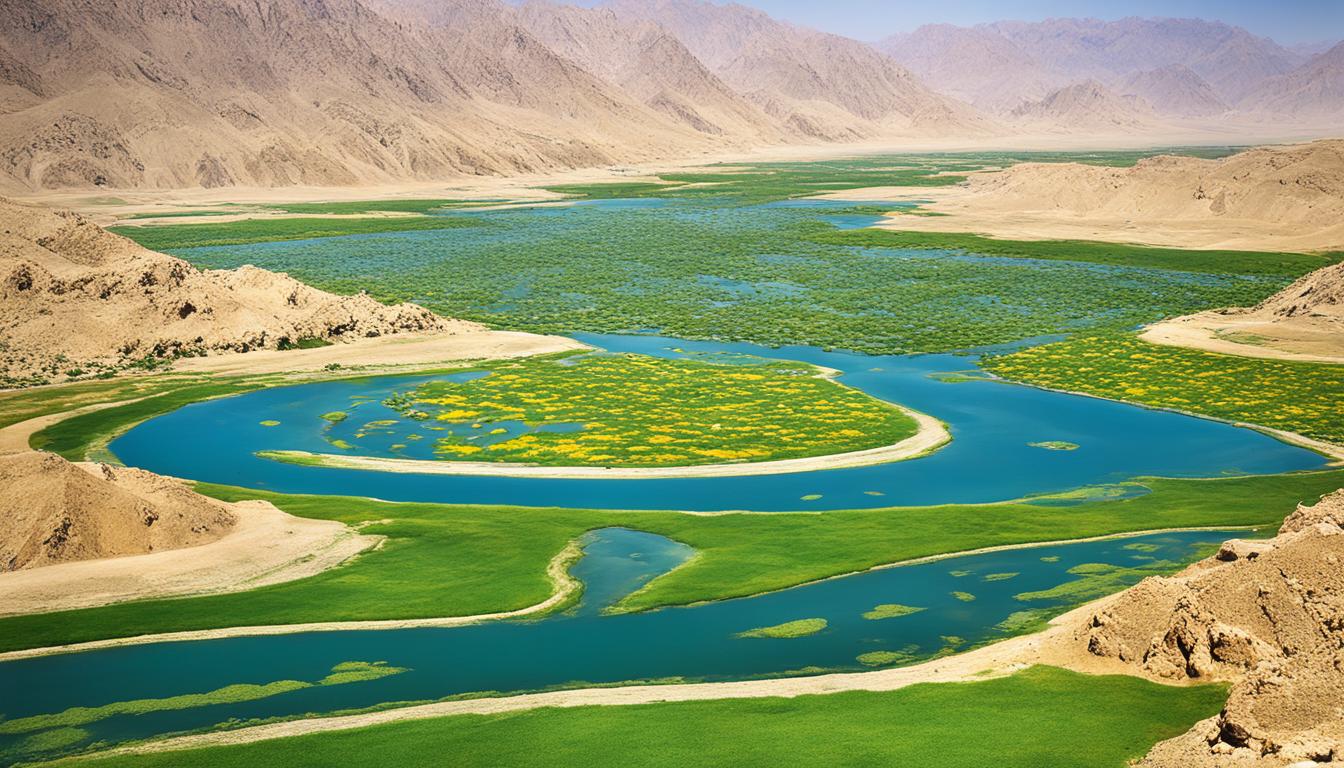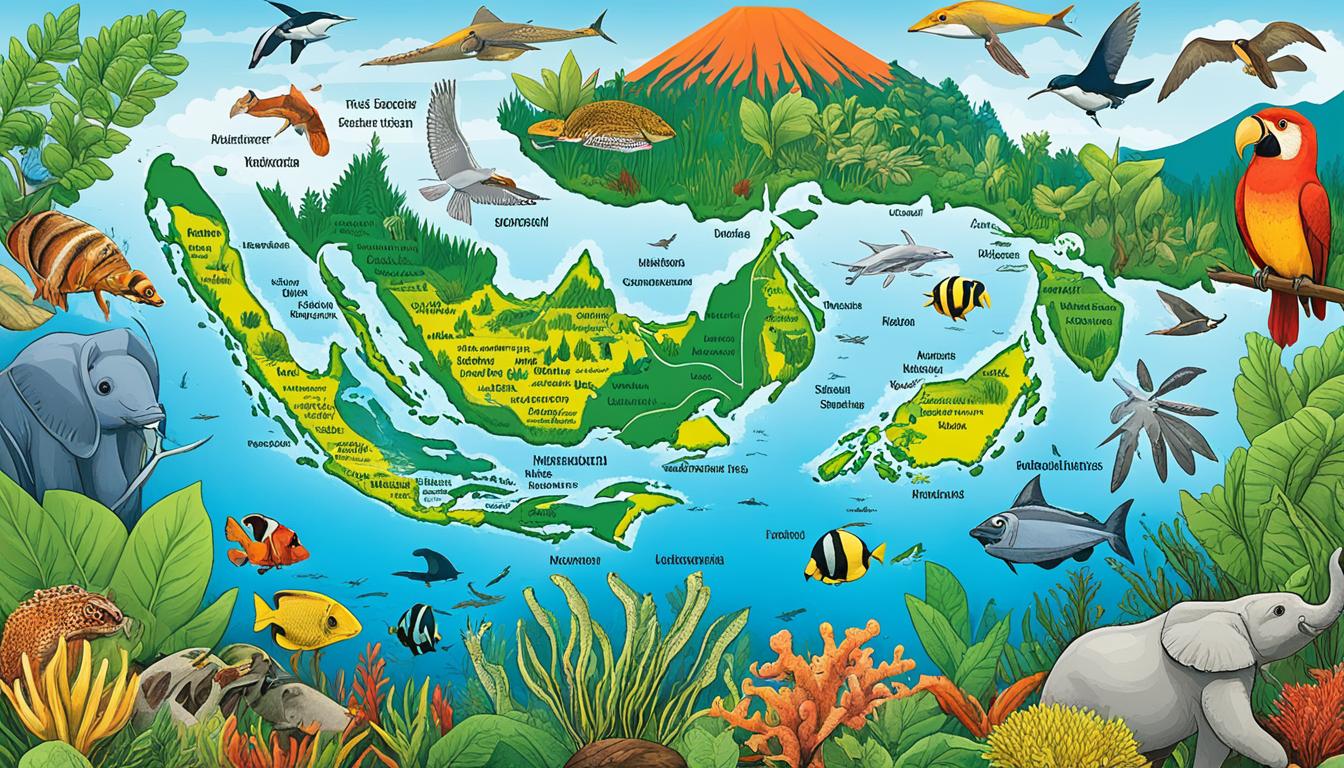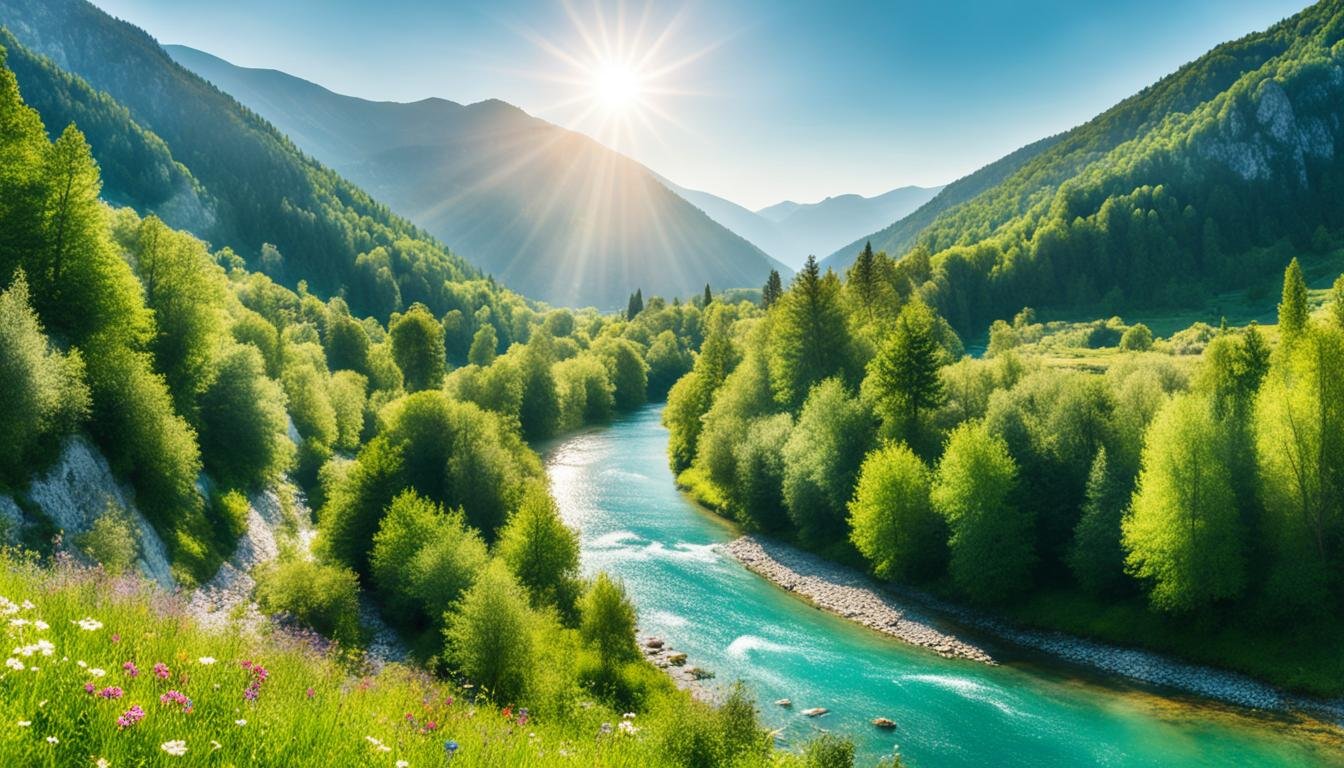Ireland Sacred Natural Sites and Biodiversity
Did you know that Ireland is home to numerous sacred natural sites that play a vital role in preserving the country’s rich biodiversity? These sites, deeply rooted in spirituality and ecology, hold immense significance for both cultural heritage and ecological preservation.
Irish Sacred Nature Locations, such as ancient forests, sacred wells, and pilgrimage sites, are not only breathtakingly beautiful but also serve as important habitats for a diverse range of plant and animal species. The fusion of spirituality and nature in these sites has resulted in a unique conservation approach that values both the natural and cultural aspects of the landscape.
In this article, we will explore the significance of sacred natural sites in Ireland, their role in cultural preservation, the challenges in their conservation, and the community-led efforts to protect and sustain them. We will also delve into sustainable tourism opportunities and the legal framework surrounding these sites.
Key Takeaways:
- Ireland is home to numerous sacred natural sites that contribute to the preservation of the country’s rich biodiversity.
- These sites hold great significance for both cultural heritage and ecological conservation.
- Challenges in the conservation of sacred natural sites include land management, human impacts, climate change, and urbanization.
- Community involvement and collaborative approaches are crucial for the successful preservation of these sacred landscapes.
- Sustainable tourism and education programs can enhance public awareness and support for the conservation of these sites.
The Significance of Sacred Natural Sites
Sacred natural sites hold great significance in Ireland. They are not only important for their ecological value but also for their cultural and spiritual importance. These sites are often associated with traditional beliefs and are considered sacred by local communities. They are seen as repositories of cultural heritage and play a crucial role in preserving Ireland’s natural biodiversity.
These sacred natural sites serve as havens for diverse plant and animal species, contributing to biodiversity conservation in Ireland. They provide a unique ecological niche and support the delicate balance of habitats, nurturing a wide range of flora and fauna. The spiritual ecology associated with these sites recognizes the interconnectedness between humans and the natural world, promoting a harmonious relationship with the environment.
Traditional beliefs and cultural heritage are deeply intertwined with these sacred sites. They hold spiritual significance as places of worship, pilgrimage, and rituals. Local communities perform ceremonies and practices that have been passed down through generations, preserving cultural identity and ancestral knowledge. These sites act as living repositories of traditional ecological knowledge, reinforcing the importance of ecological preservation.
“Sacred natural sites are not only about nature conservation; they are about the conservation of our cultural heritage, our traditional beliefs, and the sustainable future of our communities.”
The preservation of sacred natural sites is crucial for maintaining the cultural fabric of Ireland. They provide a sense of place and belonging, fostering a connection between individuals and their ancestral lands. These sites are integral to the cultural identity of local communities and contribute to the overall cultural heritage of the nation.
Moreover, the conservation of these sites is essential for the long-term ecological sustainability of Ireland. They serve as ecological hotspots, promoting the preservation of unique habitats and ecosystems. By safeguarding these sacred natural sites, we ensure the protection of Ireland’s natural biodiversity and the delicate balance of its ecosystems.
Recognizing the significance of sacred natural sites and their intrinsic value in terms of biodiversity conservation and cultural heritage preservation is essential. Collaborative efforts between local communities, government agencies, and conservation organizations can help develop sustainable management practices that respect the spiritual, cultural, and ecological aspects of these sites.
Sacred Natural Sites and Cultural Preservation
Sacred natural sites in Ireland are intricately connected to the preservation of culture. These sites play a significant role in safeguarding traditional practices, indigenous knowledge, and cultural identity. As living landscapes, they provide a space for the performance of rituals and ceremonies that actively preserve and pass on cultural traditions and spiritual beliefs.
The sacred landscapes of Ireland are not only physical spaces but also repositories of intangible cultural heritage. They serve as a bridge between the past and the present, allowing communities to engage with their ancestral practices and maintain a sense of cultural continuity.
Through the preservation of these sacred natural sites, Ireland upholds its rich cultural heritage and creates opportunities for future generations to connect with their roots. The recognition and protection of these sites are vital for sustaining the diverse cultural identities that make up the fabric of Irish society.
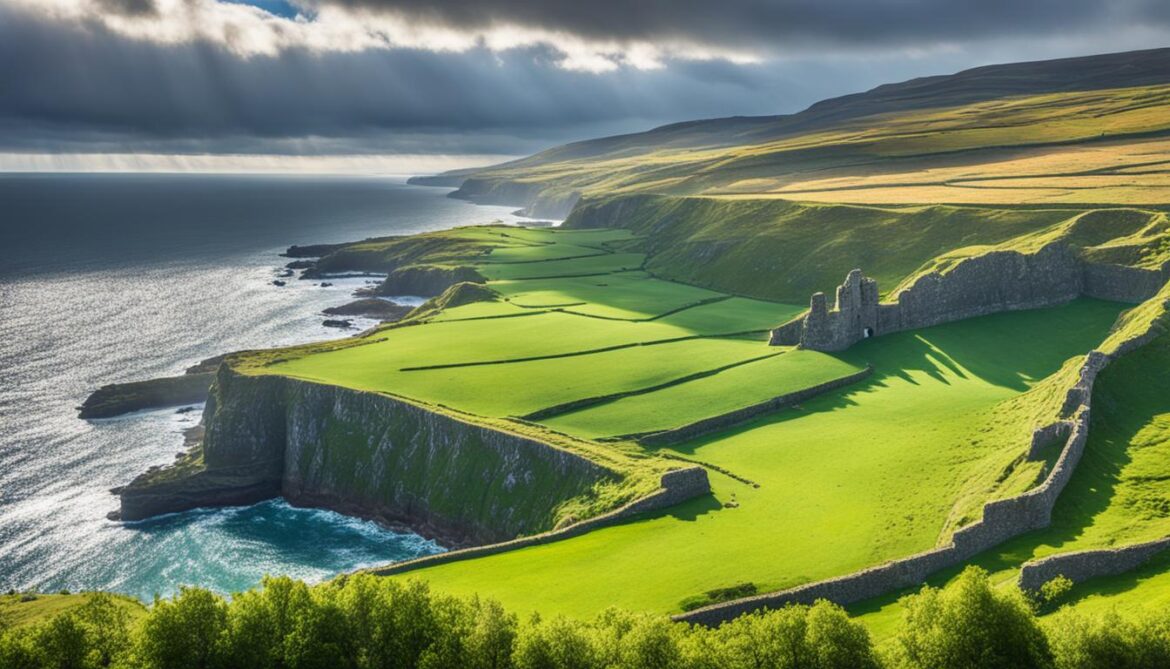
The Significance of Sacred Landscapes
“Sacred natural sites are more than just physical locations; they are the living embodiment of our cultural identity and a testament to our ancestors’ wisdom.” – Irish traditional elder
| Traditional Practices | Indigenous Knowledge | Rituals and Ceremonies |
|---|---|---|
| Traditional practices, such as herb gathering or pilgrimage, are rooted in the cultural history of Ireland. | Indigenous knowledge, passed down through generations, is preserved and celebrated in sacred landscapes. | Rituals and ceremonies honor sacred connections and maintain a spiritual bond with the natural world. |
The engagement with traditional practices, indigenous knowledge, and the performance of rituals and ceremonies fosters a sense of belonging and strengthens cultural identity. By actively preserving these sacred landscapes, Ireland ensures the continuity of its rich cultural heritage for generations to come.
Biodiversity Conservation in Sacred Natural Sites
Sacred natural sites in Ireland play a vital role in the conservation of biodiversity. These sites serve as important habitats for a wide range of plant and animal species, including several that are considered endangered. The preservation of these sacred sites is essential for maintaining Ireland’s natural heritage and protecting its unique ecosystems.
The presence of diverse plant and animal life in these sacred natural sites contributes to overall ecosystem preservation. The interconnected relationships between different species within these sites create a balanced and healthy ecosystem, ensuring the sustainability of natural resources and promoting the well-being of all living organisms.
Habitat protection is a key component of biodiversity conservation in sacred natural sites. By safeguarding these sites from destructive human activities and promoting responsible land management practices, we can preserve the natural habitats that support a variety of species. This ensures the long-term survival and perpetuation of both common and rare plant and animal species.
Endangered species, in particular, benefit greatly from the conservation efforts focused on sacred natural sites. These sites can provide crucial refuges for endangered plants and animals, allowing them to thrive and recover in a protected environment. By protecting the habitats of these vulnerable species, we contribute to the overall conservation of biodiversity in Ireland.
Preserving the natural heritage found in sacred natural sites is of utmost importance. These sites often contain unique and irreplaceable elements of Ireland’s natural history, including rare species, endemic plants, and ancient ecosystems. By conserving these sites, we ensure that future generations can experience and appreciate the rich diversity of Ireland’s natural heritage.
Conservation efforts aimed at protecting sacred natural sites are crucial for maintaining Ireland’s biodiversity and safeguarding its natural legacy. By working collectively to preserve these sites, we can ensure the continued existence of endangered species, the preservation of unique ecosystems, and the conservation of Ireland’s natural heritage.
Endangered Species Protected in Sacred Natural Sites
| Species | Status | Habitat |
|---|---|---|
| Red Squirrel | Endangered | Forests |
| Peregrine Falcon | Endangered | Cliffs and Mountains |
| Irish Lady’s Tresses Orchid | Endangered | Grasslands |
| Marsh Fritillary Butterfly | Endangered | Wetlands |
Challenges in the Conservation of Sacred Natural Sites
Conservation of sacred natural sites in Ireland presents a range of land management and human impacts that pose significant challenges to their preservation. These challenges must be addressed to ensure the long-term sustainability of these sacred locations and the biodiversity they support.
- Land Management: One of the key challenges in conservation is effective land management. As sacred natural sites often span large areas, managing and protecting these lands from encroachment and unsustainable use becomes crucial.
- Human Impacts: Human impacts such as pollution, habitat degradation, and resource extraction can severely affect the ecological balance and biodiversity of sacred natural sites. Ensuring sustainable practices and minimizing human-induced disturbances are necessary.
- Climate Change: Climate change poses a significant threat to sacred natural sites in Ireland. Rising temperatures, changes in precipitation patterns, and increased frequency of extreme weather events can alter ecosystems, leading to habitat loss and endangering species.
- Urbanization: The rapid urbanization and development of surrounding areas can put immense pressure on sacred natural sites. Increased infrastructure, population, and associated activities can disrupt the delicate ecological balance of these sites.
- Policy Framework: Establishing a robust policy framework is essential to address the conservation challenges faced by sacred natural sites. Adequate legislation, guidelines, and enforcement mechanisms can provide the necessary tools for effective management and protection.
Overcoming these challenges requires a multi-faceted approach that involves collaboration between various stakeholders, including government bodies, local communities, conservation organizations, and indigenous communities. By implementing sustainable management practices, raising awareness, and developing adaptive strategies, it is possible to safeguard Ireland’s sacred natural sites for future generations.
“Conserving sacred natural sites necessitates finding a delicate balance between human activities and the protection of these culturally and ecologically significant landscapes.” – Professor Sarah Murphy, Environmental Conservationist
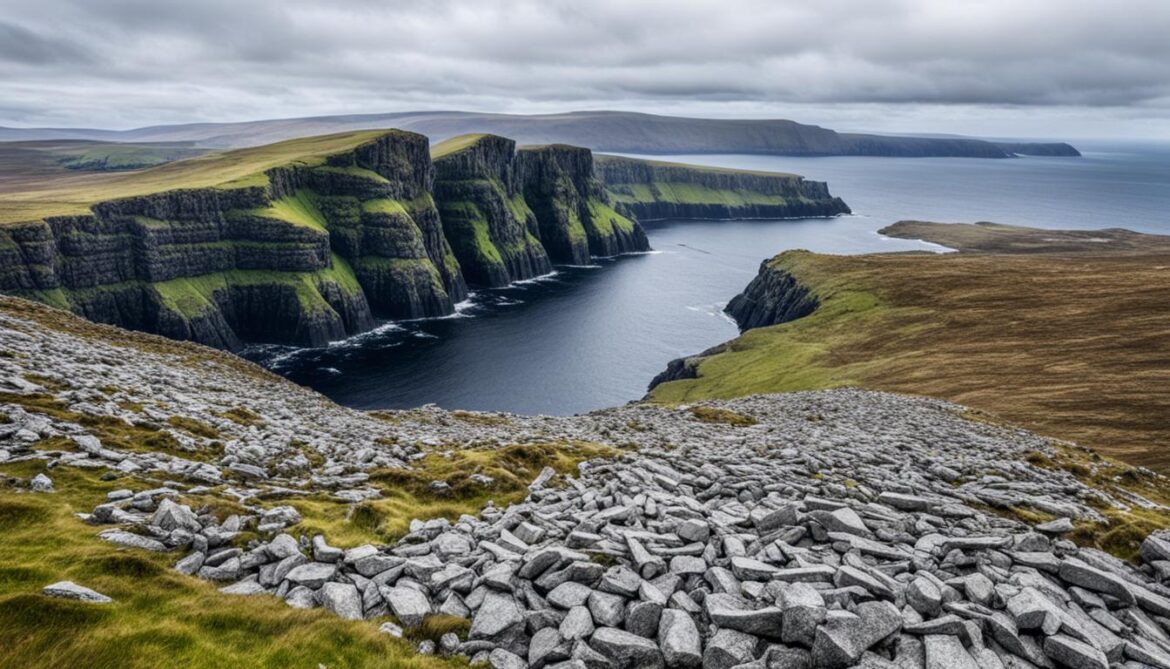
| Conservation Challenges | Implications |
|---|---|
| Land Management | Loss of habitat, encroachment, unsustainable use |
| Human Impacts | Habitat degradation, pollution, disturbance to biodiversity |
| Climate Change | Habitat loss, altered ecosystems, species endangerment |
| Urbanization | Ecosystem disruption, loss of ecological balance |
| Policy Framework | Inadequate protection, lack of management guidelines |
Community Involvement in Sacred Natural Sites Conservation
In Ireland, the conservation of sacred natural sites relies heavily on community participation and local stewardship. These sites hold immense cultural and ecological value and are often entrusted to the care of the local communities.
Traditional Ecological Knowledge plays a vital role in the conservation efforts of these sacred landscapes. Passed down through generations, this knowledge integrates indigenous wisdom and practices with modern conservation strategies.
Community-based conservation approaches, rooted in collaboration and empowerment, have shown promising results in preserving these sacred sites and their surrounding ecosystems.
By actively involving indigenous communities in the management and decision-making processes, collaborative management models have been able to bridge the gap between traditional and contemporary conservation practices.
This approach not only strengthens the bond between local communities and their sacred landscapes but also enhances the effectiveness of conservation efforts by leveraging the intimate understanding of the sites’ ecological dynamics.
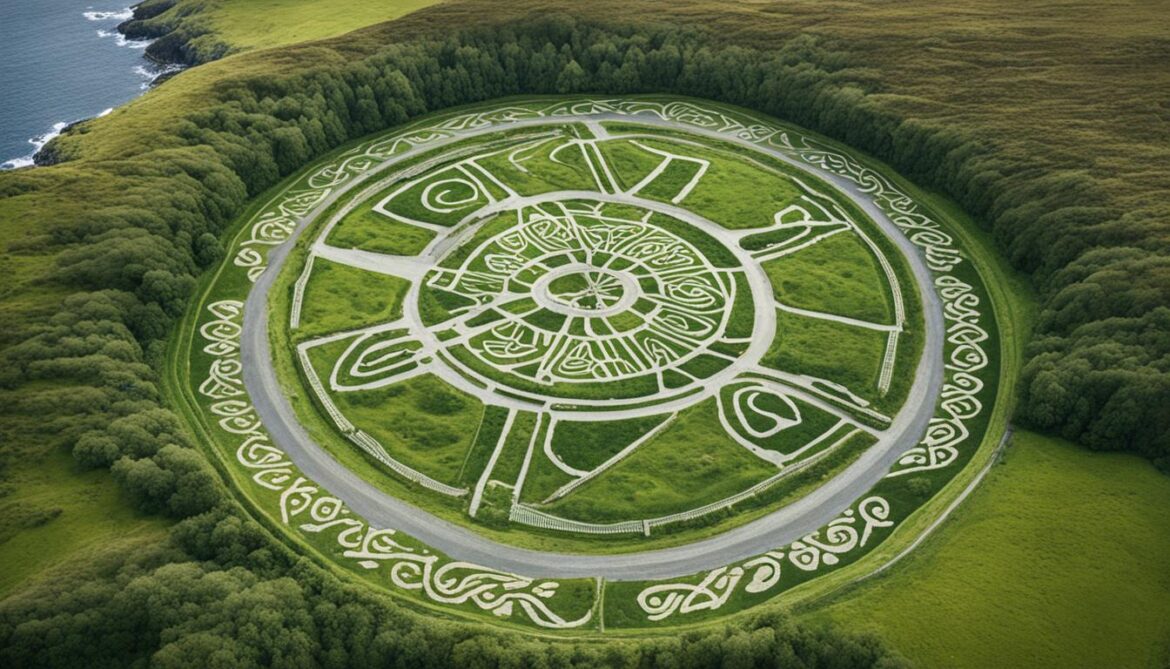
Empowering Indigenous Communities
Empowering indigenous communities is a key aspect of community-based conservation. By recognizing and respecting their rights, knowledge, and cultural connections to the land, these communities can actively contribute to the preservation of sacred natural sites.
Through co-management initiatives, indigenous communities are given the opportunity to actively engage in decision-making processes, land-use planning, and the implementation of conservation strategies.
This collaborative approach fosters a sense of ownership and responsibility among the communities, encouraging them to become guardians and advocates for their sacred landscapes.
Local Stewardship and the Preservation of Traditional Ecological Knowledge
Local stewardship is crucial in maintaining the integrity and ecological health of sacred natural sites. Through their deep connection to the land and their inherent cultural practices, local communities act as custodians, ensuring the sustainable use of resources and the preservation of these sacred landscapes.
The transmission of Traditional Ecological Knowledge from one generation to another ensures the continuity of sustainable practices and the long-term preservation of these sites.
Benefits of Community Involvement
The involvement of local communities in the conservation of sacred natural sites brings numerous benefits:
- Enhanced ecological resilience through sustainable land-use practices
- Preservation of cultural heritage and traditional practices
- Increased awareness and appreciation of the sites’ cultural and ecological value
- Strengthened community cohesion and pride
- Improved biodiversity conservation outcomes
Overall, community participation and collaborative approaches are essential in safeguarding Ireland’s sacred natural sites, ensuring their continued preservation for future generations.
Sustainable Tourism and Sacred Natural Sites
Sacred natural sites in Ireland offer tremendous potential for sustainable tourism. By developing cultural tourism and ecotourism initiatives, we can create opportunities for responsible travel and meaningful cultural exchange. Such initiatives not only benefit tourists but also contribute to the local economies and the preservation of these sacred landscapes.
Sustainable tourism practices are essential for minimizing the negative environmental and socio-cultural impacts of tourism. By promoting responsible travel, we can ensure that visitors respect and appreciate the sacredness of these natural sites, preserving their spiritual and ecological value. Sustainable tourism also emphasizes cultural exchange, allowing visitors to engage with the local communities and gain a deeper understanding of their traditions, customs, and spiritual beliefs.
“Sustainable tourism is about respecting and protecting the natural and cultural heritage of a destination while providing meaningful experiences for tourists.”
Cultural tourism focuses on experiencing the unique culture and heritage of a place. In the case of sacred natural sites in Ireland, cultural tourists can explore the intertwined relationship between spirituality and ecology. They can witness traditional rituals and ceremonies, learn about indigenous practices, and gain a deeper appreciation for the cultural significance of these landscapes.
On the other hand, ecotourism promotes environmental conservation and preservation. It allows tourists to enjoy the natural beauty of sacred sites while minimizing their ecological footprint. Through guided tours, educational programs, and sustainable practices, ecotourism initiatives can enhance visitors’ understanding of the importance of protecting biodiversity and ecosystems.
Benefits of Sustainable Tourism for Local Communities
One of the key advantages of sustainable tourism is its positive impact on local economies. By attracting responsible tourists, sacred natural sites can support local businesses, such as accommodations, restaurants, and souvenir shops. This economic boost provides opportunities for local communities to thrive and continue their cultural traditions.
Sustainable tourism also fosters community involvement and cultural preservation. As local residents engage with tourists, they have the chance to share their stories, knowledge, and traditions. This interaction not only enhances cultural exchange but also empowers local communities to participate in the conservation and management of these sacred sites.
An Example: Sustainable Tourism in Ireland’s Ancient East
Ireland’s Ancient East is a region renowned for its wealth of sacred sites, historic landmarks, and cultural heritage. By embracing sustainable tourism practices, this region has emerged as a popular destination for visitors seeking authentic experiences and a deeper connection with nature and history.

| Benefits of Sustainable Tourism in Ireland’s Ancient East | Examples |
|---|---|
| Preserving cultural heritage | Guided tours of ancient monastic sites |
| Supporting local economies | Local restaurants and accommodations |
| Promoting environmental conservation | Eco-friendly adventure activities |
| Facilitating cultural exchange | Heritage festivals and events |
Through collaborations between government agencies, local communities, and tourism operators, sustainable tourism initiatives have transformed Ireland’s Ancient East into a vibrant and sustainable destination. Visitors can enjoy the beauty of sacred natural sites, support local economies, and learn about Ireland’s rich cultural heritage, all while contributing to their preservation.
By embracing sustainable tourism, we can ensure the long-term conservation of sacred natural sites in Ireland, while providing enriching experiences for tourists and supporting local communities. Let us collectively strive for responsible and sustainable travel practices that preserve the spiritual and ecological value of these remarkable landscapes.
Legal Protection of Sacred Natural Sites
The legal framework plays a crucial role in ensuring the long-term preservation of sacred natural sites in Ireland. Conservation legislation and heritage designations provide the necessary framework for protecting these sites and their unique cultural and environmental significance. However, further recognition and inclusion of these sites within the legal framework is necessary to effectively conserve them.
The establishment of protected areas is a key component of the legal framework for sacred natural sites conservation. These designated areas ensure the preservation of these sites by providing legal protection and management plans that prioritize their ecological and cultural values. Protected areas help to safeguard the integrity and biodiversity of these sacred landscapes.
Conservation legislation acts as a guiding force in protecting sacred natural sites. These laws outline the responsibilities and mechanisms for preserving these sites, including regulations on land use, habitat protection, and heritage preservation. Conservation legislation helps to regulate activities and promote sustainable management practices to mitigate threats to these sites.
“The legal recognition of sacred natural sites as cultural landscapes is vital for their preservation. This recognition ensures that their unique cultural values are considered in land management decisions and development plans,” says Dr. Emma Kelly, a specialist in environmental law.
Heritage designation is another important aspect of legal protection. By designating certain sacred natural sites as cultural or natural heritage sites, they are granted legal status and recognition for their outstanding universal value. This designation helps to raise public awareness, ensure proper management, and secure funding for the conservation and restoration of these sites.
The legal framework also incorporates environmental regulations to protect the ecosystems within sacred natural sites. These regulations address issues such as pollution control, habitat preservation, and restoration efforts. Environmental regulations aim to prevent and mitigate the negative impacts of human activities on these sites, ensuring their ecological integrity and long-term sustainability.
Comparison of Legal Protection Mechanisms for Sacred Natural Sites
| Legal Mechanism | Description |
|---|---|
| Protected Areas | Designated areas with legal protection and management plans |
| Conservation Legislation | Laws and regulations guiding preservation and sustainable management |
| Heritage Designation | Recognition of outstanding cultural or natural value |
| Environmental Regulations | Measures to address pollution, habitat preservation, and restoration |
The legal protection of sacred natural sites in Ireland is essential for their conservation and sustainable management. While existing conservation legislation and heritage designations provide a foundation for protection, continuous efforts are needed to enhance their legal recognition and ensure the effective safeguarding of these culturally and ecologically important sites.
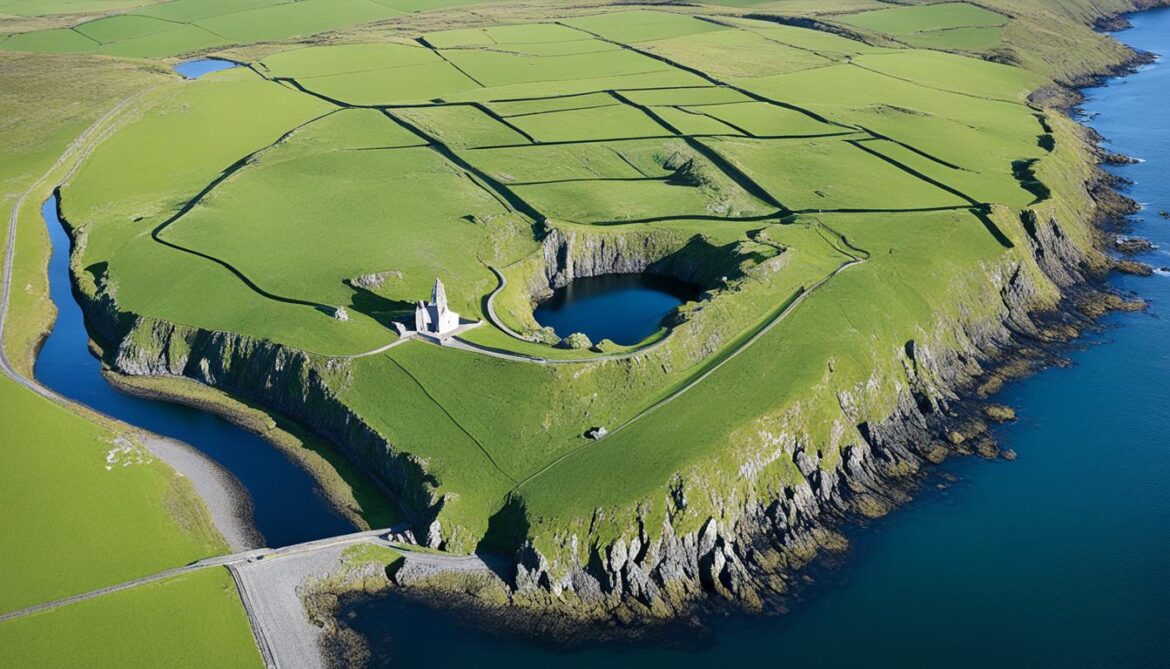
Education and Awareness for Sacred Natural Sites Conservation
Education and awareness programs are essential for promoting the conservation of sacred natural sites in Ireland. By increasing public knowledge and understanding, these programs play a crucial role in preserving Ireland’s rich cultural heritage and diverse ecosystems.
Cultural Heritage Awareness
One of the key focuses of education programs is to raise awareness about the cultural significance of sacred natural sites. By exploring the history and traditions associated with these sites, individuals gain a deeper appreciation for their importance in shaping Ireland’s cultural identity. Understanding the connection between cultural heritage and sacred landscapes encourages a sense of responsibility for their conservation.
Environmental Education
Environmental education forms another vital component of these programs. By providing information about the ecosystems and biodiversity found in sacred natural sites, individuals develop an understanding of the ecological value they offer. Learning about the intricate relationships between different species and their habitats fosters a sense of stewardship and inspires action to protect these fragile environments.
Indigenous Perspectives
Incorporating indigenous perspectives is essential for a holistic understanding of sacred natural sites. These perspectives bring forward traditional ecological knowledge and highlight the deep spiritual connections that indigenous communities have with these landscapes. By learning from the wisdom of indigenous cultures, individuals gain a greater appreciation for the interconnectedness of all living beings and the need for their preservation.
“Sacred natural sites are not just places of cultural and ecological importance; they are also classrooms where we can learn valuable lessons about our role in protecting and sustaining the natural world.” – Dr. Emma O’Brien, Environmental Educator
Outreach Initiatives
Outreach initiatives play a crucial role in engaging the wider public in the conservation of sacred natural sites. These initiatives can take the form of workshops, community events, or guided tours that provide immersive experiences and firsthand interactions with these landscapes. By actively involving people in these initiatives, awareness is increased, and a sense of personal connection and responsibility is fostered.

Education and awareness programs for the conservation of sacred natural sites not only empower individuals with knowledge but also foster a sense of stewardship and responsibility. By working together to protect these sites, we can ensure that Ireland’s cultural heritage and ecological diversity are cherished and preserved for generations to come.
| Benefits of Education Programs for Sacred Natural Sites Conservation | Examples |
|---|---|
| Increased public awareness and appreciation for cultural heritage and biodiversity | 1. Heritage awareness workshops 2. Guided tours of sacred sites |
| Development of environmental stewardship and responsible behavior | 1. Ecological education programs 2. Conservation-themed events |
| Strengthened relationships between indigenous communities, local residents, and authorities | 1. Indigenous knowledge sharing sessions 2. Collaborative governance initiatives |
| Enhanced community engagement and participation in conservation efforts | 1. Citizen science projects 2. Community-based restoration activities |
Collaboration and Partnerships for Sacred Natural Sites Conservation
Collaborative approaches and partnerships play a vital role in the successful conservation of sacred natural sites in Ireland. By bringing together diverse stakeholders, such as government agencies, nonprofit organizations, and indigenous governance, we can develop effective management strategies and ensure the long-term preservation of these treasured landscapes.
Stakeholder engagement is key to fostering a shared sense of responsibility and creating a collective vision for conservation efforts. Government agencies, with their regulatory powers and resources, can provide vital support and implement policies that protect these sites. Nonprofit organizations, driven by their commitment to environmental and cultural preservation, bring valuable expertise and advocacy to the table. Indigenous governance ensures that the rights and perspectives of the local communities closely connected to these sacred sites are respected and integrated into conservation plans.
“Conservation is a collaborative effort that requires the active involvement and cooperation of all stakeholders. Together, we can protect and conserve these sacred natural sites for future generations.”
Benefits of Collaboration and Partnerships
Collaborative approaches and partnerships offer several benefits for the conservation of sacred natural sites:
- Pooled resources and expertise: By working together, stakeholders can pool their resources and expertise, creating a more comprehensive and robust approach to conservation.
- Enhanced knowledge sharing: Collaboration fosters the sharing of traditional ecological knowledge, scientific research, and best practices, promoting informed decision-making.
- Increased funding opportunities: Partnerships can open doors to funding opportunities that might not be available to individual organizations, ensuring sustainable financial support for conservation initiatives.
- Improved coordination and communication: Collaborative efforts facilitate better coordination and communication among stakeholders, enabling efficient planning and implementation of conservation actions.
Success Stories: Collaborative Conservation Efforts
| Initiative | Main Stakeholders | Achievements |
|---|---|---|
| The Sacred Land Project | Government agencies, nonprofit organizations, indigenous communities | Developed a comprehensive management plan for sacred natural sites, integrating cultural preservation and biodiversity conservation |
| The Biodiversity Partnership | Government agencies, environmental NGOs, local communities | Conducted habitat restoration projects in sacred landscapes, leading to increased biodiversity and community involvement |
| The Indigenous Governance Model | Government agencies, indigenous communities | Established a framework for active indigenous governance in the conservation and management of sacred natural sites |
These success stories demonstrate the power of collaboration and partnership in achieving tangible results for the conservation of sacred natural sites in Ireland.
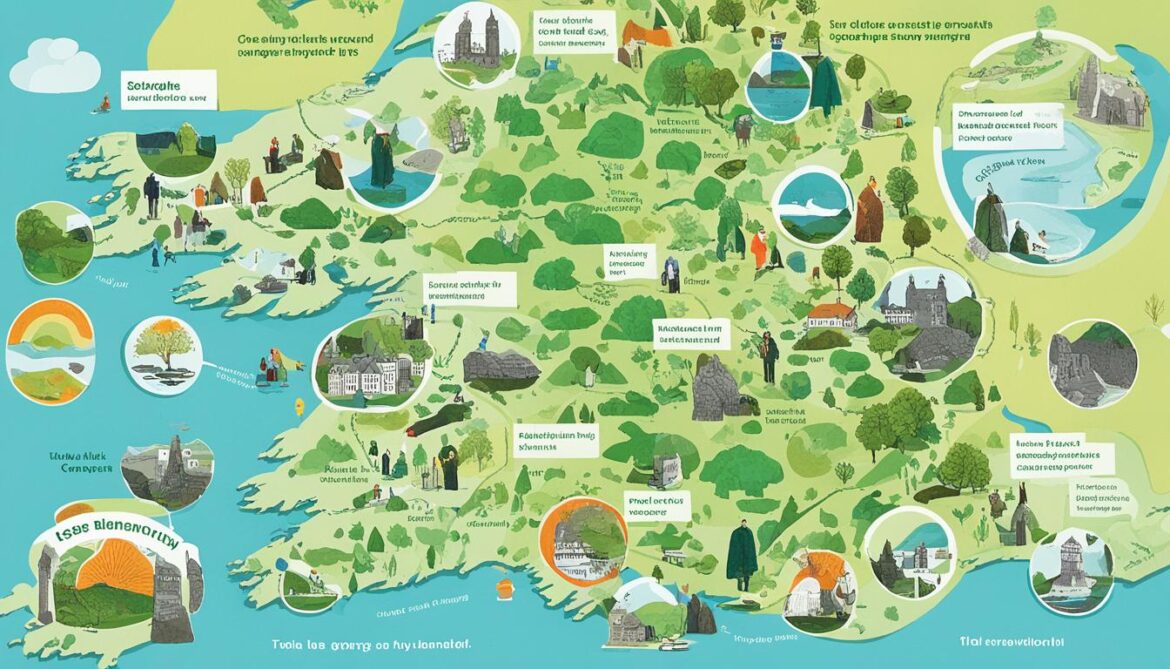
The image above illustrates the spirit of collaboration and partnership, symbolizing the diverse stakeholders coming together to protect and conserve sacred natural sites.
Conclusion
In conclusion, the conservation of sacred natural sites in Ireland plays a paramount role in both biodiversity conservation and cultural preservation. These sites hold immense ecological value and are regarded as cultural treasures by local communities. To ensure their long-term preservation, it is imperative to implement sustainable management practices that prioritize the protection of biodiversity and cultural heritage.
Community engagement is vital in this endeavor, as it fosters a sense of ownership and stewardship among local residents. By involving communities in the conservation efforts, indigenous knowledge and traditional practices can be incorporated into the management strategies, enhancing the effectiveness and sustainability of the conservation initiatives.
A robust policy framework that recognizes the significance of these sites is essential. By integrating the conservation of sacred natural sites into existing environmental policies and regulations, we can ensure their legal protection and create a solid foundation for their preservation.
Furthermore, education and awareness programs are critical in fostering public understanding and support for these sites. By raising awareness of the ecological and cultural value of sacred natural sites, we can inspire individuals to become advocates for their conservation and foster a deeper appreciation for the interconnectedness of biodiversity and cultural heritage.




